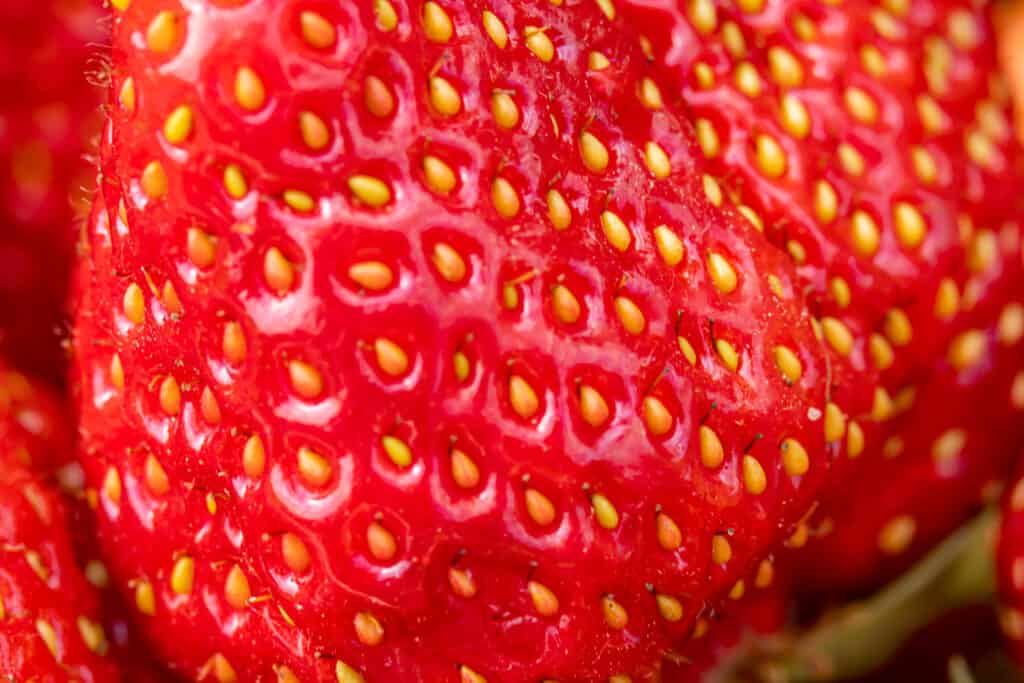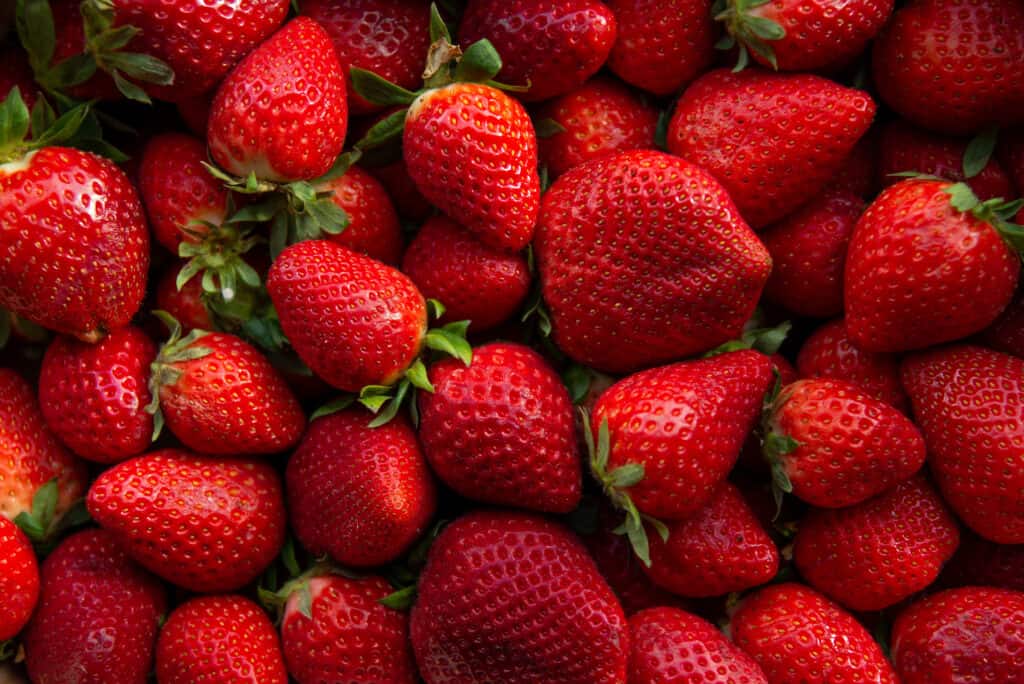One of the finest summertime joys is biting into strawberries that have been left to mature and warm slightly in the sun, but still taste so incredibly fresh when you bite into them. Strawberries are excellent fruits to grow at home in small spaces, as just a few rows of plants will fill your refrigerator and freezer during the harvest season. You can take advantage of a delectable profusion of sweet fruits from spring until the first frost in the fall by planting several different cultivars of strawberries in your garden or in containers. And the best part is that they’re incredibly easy to grow, even if you lack a green thumb.
We’ll take a look at some intriguing strawberry-related information and home strawberry-growing techniques in this guide. Follow these suggestions to cultivate strawberries that are even better than those you can buy at the grocery store!
The Botanical Name and History of Strawberries
The strawberry plant, also known as the garden strawberry, is classified as Fragaria × ananassa. The Fragaria genus has several hybrid species, including the widely cultivated strawberry, which is farmed for its fruit all over the world. The fruit’s distinctive scent, vivid red color, juicy texture, and sweetness are all characteristics that have led to its popularity. Large amounts of it are consumed annually, either fresh or in prepared dishes like jam, juice, pies, drinks, and chocolates. Just as well, artificial strawberry flavorings and scents are often employed as a flavoring in everything from gourmet chocolates to candles to children’s medications.
In 1714, a hybrid between the Fragaria virginiana strawberry from North America and the Fragaria chiloensis strawberry, an imported species from Chile, led to the creation of the modern-day garden strawberry in Brittany, France. Fragaria vesca, the original strawberry species grown in the early 17th century, has been superseded in commercial production by cultivars of Fragaria ananassa. Ancient Roman literature made reference to the strawberry fruit’s healing properties. In the 14th century, the French started bringing strawberries from the wild to their gardens for harvest. Strawberries are currently one of the most commonly grown fruits in the world. Nine million tons of strawberries were produced globally in 2019 alone.
From a botanical standpoint, the strawberry is not a berry. Strictly speaking, it is an aggregation accessory fruit, which means that the fleshy portion comes from the part of the plant that holds the ovaries rather than the actual ovaries themselves. Each ovum of the flower, which will have a seed inside it, makes up each apparent seed on the outside of the fruit.
There are many varieties of strawberries out there. Strawberries come in three primary varieties: June-bearing, ever-bearing, and day-neutral. USDA hardiness zones six through 10 are ideal for growing June-bearing strawberries like the Shuksan variety, although certain cultivars will perform better in your region than others. You could get a good yield of strawberries in April if you keep in mind that June-bearers will produce their harvest early in warm regions. Ever-bearing or day-neutral strawberries will be your best option in zones six through eight, with the exception of hot and humid regions. The Quinault variety is an example of an ever-bearing variety that produces two crops: one in June and one in September. Day-neutral varieties, like the Tristar strawberry, will continuously produce a lesser harvest from June through September.

Strawberries (pictured) are technically not berries but rather an aggregation accessory for the plant.
©iStock.com/Oleg Prolat
Climate and Hardiness Zone Requirements for Strawberries
The hardiness zone and climate for strawberries depend on the variety you have. In general, though, the majority of strawberry plants can survive in USDA hardiness zones four through nine. Strawberries grown in gardens do best at temperatures between 60 and 80 degrees F. As long as the plant is shielded from frost, though, it can withstand temperatures as low as 22 degrees F. If this sounds like your climate, you can easily grow most strawberries outdoors.
When to Grow Strawberries
Strawberries are perennial plants, thus the plants will grow every year. Hence, investing the time to give them a head start will be worthwhile in the long term. After the last spring frost or in the fall before the first anticipated frost to overwinter, bareroot strawberries can be planted at any time. Nevertheless, if you grow strawberries from seed, you’ll need to help them along by keeping them indoors in the early spring until the final frost has passed.
Starting Strawberries From Seed vs. Buying Adult Plants
Juvenile and mature strawberry plants can easily be found at garden centers and nurseries. Buying an already mature plant is definitely easier than growing a plant from seed. However, there’s not as much fun in that! Just as well, growing strawberries from seed guarantees that you can plant whatever variety you want instead of settling for grown plants that are available.
Starting the process of cultivating strawberries from seed is best done around December. Stratifying the strawberry seeds is a necessary step before planting them. This involves providing the seeds with a cooling time to aid in germination. For three to four weeks, place the entire seed pack in your freezer. Take the seeds out of the freezer after they have frozen, then let them thaw to room temperature.
In seed starting trays, thinly sow the seeds by pushing them into a damp potting media and then cover them with a growth mix. Since strawberries require light to germinate, place the tray beneath grow lights or near indirect sunlight. Give the seeds a few weeks to germinate. Be patient; germination times for seedlings range from one to six weeks. Keep up a temperature range of 65 to 75 degrees F for the seed tray. Keep the seeds from drying out by misting the soil regularly. To prevent damping off, provide adequate airflow to the trays.
Keep the grow light two inches above the plant after the seeds start to sprout. Leggy, thin plants result from light that is too far away from the seedlings. Transfer the strawberries into bigger containers once the seedling has developed and formed three sets of (adorable) leaves. Before putting your plants in the garden or outdoor pots, harden them off. After the final spring frost, plant them in your garden.

Growing strawberries (pictured) from seed is usually preferable over buying a full plant from a store.
©Erika Anes/Shutterstock.com
How to Grow Strawberries
Strawberries can grow almost anywhere. They can be interplanted in places that need ground cover as well as raised beds, containers, and in-ground gardening. Just as well, their roots don’t get very deep.
Strawberries should be planted in rich, wet soil, spaced about a foot apart. To guarantee the plants are well-rooted by the next year, put them outside in zones six and higher throughout the spring. In order to encourage the plants to focus their efforts on root development, it is often advised to pinch off all of the flowers during the first year, particularly on June-bearing varieties. In zones seven and farther south, garden strawberries can be planted in the autumn and will bear fruit the following spring.
Soil and Fertilizer Requirements for Strawberries
For optimum output, garden strawberry plants require rich, loamy soil with a pH of 5.9 to 6.2. Strawberries should be planted so that the crown is exposed to sunshine and fresh air while the roots are completely covered in soil. Deep burial will cause the plant to decay. Before planting, use a balanced fertilizer at a rate of one pound per 100 square feet starting with organic, compost-rich soil. Re-fertilize June-bearers after reconstruction, or day-neutrals and ever-bearing varieties after the second harvest. Avoid overfertilizing, which causes poor blooming and excessive leaf development. Just as well, if you live in a colder region, avoid fertilizing strawberries later in the season since you don’t want any new growth to be harmed by frost.
Water Requirements for Strawberries
Provide one to two inches of water every week for some seriously luscious strawberries. From the beginning of the bloom period to the conclusion of harvest, regular watering is particularly crucial when the fruit is developing. Avoid overwatering in the winter.
Temperature and Humidity Requirements for Strawberries
Strawberries grown in gardens do best at temperatures between 60 and 80 degrees F. As mentioned earlier in this guide, as long as the plant is shielded from frost, it can withstand temperatures as low as 22 degrees F. It’s important to provide the plants with enough air circulation since high humidity might promote the growth and spread of powdery mildew and other forms of mold.
Sunlight Requirements for Strawberries
Make sure your growing place receives at least six to eight hours of direct sunlight each day because most strawberry plant varieties thrive in bright, sunny environments. It can handle even longer sunny days, but it will not tolerate a lack of sunlight very well. Keeping strawberries in dim spots will result in some seriously puny yields.
How Long Do Strawberries Take to be Ready for Harvest?
It will take about four to six weeks for strawberry fruits to be ready for harvest. You should only harvest very red or ripe strawberries. Do not harvest daily; instead, harvest every three days or so. Only harvest about a third of the plant’s fruits per harvest.
Though the fruit will appear earlier in warmer locations, garden strawberries will start to produce fruit in the late spring over a period of approximately three weeks. When completely matured on the vines, strawberries are at their tastiest. The only way to be sure your strawberries are ripe is to taste the berries, which for the majority of varieties involves keeping them on the vine for a day or two after they turn completely red. Keep in mind that these fruits will bruise if manhandled, so harvest them gently.
Strawberry Companion Plants
Herbs do well when planted with strawberries. A few popular options are catnip, dill, chives, thyme, and borage. Avoid planting tomatoes, potatoes, and peppers near strawberries, as they can spread verticillium disease which can kill strawberry plants. It’s also wise to avoid planting cabbages next to your strawberries.
Strawberries are delightful little plants to grow in either pots or outdoor gardens. You only need a few plants to produce very impressive yields, which makes them perfect for those who only have a small amount of space to grow fruit at home. Pick up some strawberry seeds today and try your luck at growing this delicious plant!
The photo featured at the top of this post is © iStock.com/romiri
FAQs (Frequently Asked Questions)
How far should I space my strawberry plants apart?
A good 18 to 20 inches apart is ideal.
When should I plant strawberries?
Plant strawberries in the springtime. They do best when planted in April.
Do strawberries come back every year?
Strawberries are perennial plants that will come back year after year.
Thank you for reading! Have some feedback for us? Contact the AZ Animals editorial team.






